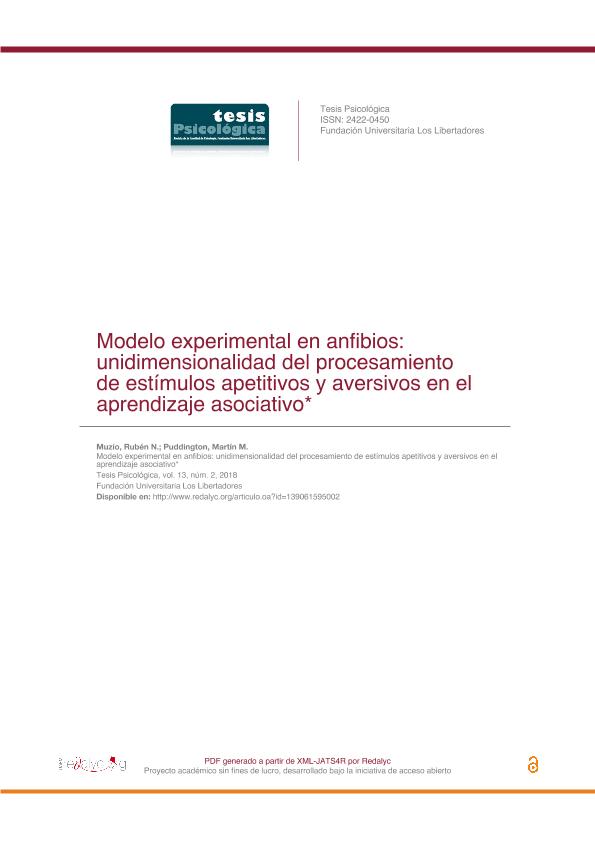Artículo
En el condicionamiento clásico,un animal es expuesto a un estímulo neutro (estímulo condicionado) seguido deun estímulo apetitivo o aversivo (estímulo incondicionado). Sucesivasrepeticiones de esta asociación generan una respuesta frente al estímulo neutrocomo si se tratara del estímulo incondicionado, fenómeno ampliamente exploradoen distintas clases zoológicas (desde invertebrados hasta humanos). En general,los estímulos incondicionados apetitivos y aversivos corresponden a víassensoriales diferentes (típicamente el estímulo utilizado como apetitivo escomida, excitando mayormente receptores gustativos; mientras que como estímuloaversivo se usa una descarga eléctrica, actuando sobre las vías táctiles ynociceptivas). Los estudios en anfibios, en particular el sapo terrestre,reproducen en buena medida los hallazgos en otras especies animales, perotienen características que los hacen únicos al poseer receptores a electrolitosen su piel que intervienen en la regulación del balance hidrosalino corporal.Un sapo expuesto a una solución salina levemente hipertónica (concentraciónmenor a 250 mM NaCl), gana peso y exhibe conductas de aproximación. Alcontrario, si la solución salina es altamente hipertónica (concentraciónsuperior a 400 mM NaCl), pierde peso y exhibe conductas de escape. Así, unmismo estímulo (una solución salina de NaCl), actúa como estímulo apetitivo oaversivo dependiendo de su concentración, característica que denominamosunidimensionalidad de los estímulos motivacionales. El presente trabajodescribe los procedimientos y revisa los resultados de estudios de aprendizajeasociativo en sapos, resaltando el uso de este modelo experimental para elanálisis de los mecanismos neurales implicados en el procesamiento de señalesambientales apetitivas y aversivas. In classical conditioning, an animal is exposed to a neutral stimulus (conditioned stimulus) followed by an appetitive or aversive stimulus (unconditioned stimulus). With successive repetitions of this association, the animal will respond to the neutral stimulus as if it were the unconditioned stimulus. is phenomenon has been widely explored in different zoological classes, covering animal species ranging from mollusks to humans. In most cases, appetitive and aversive unconditioned stimuli correspond to different sensory pathways. For example, the appetitive stimulus typically used is food and the typical aversive stimulus is electric shock. us one type of stimulus will excite the receptors related to the sense of taste, while the other type will do so mostly on the tactile and nociceptive pathways. Studies on amphibians, particularly the terrestrial toad, reproduce to a large extent the findings in other animal species, but they have characteristics that make them unique by having electrolyte receptors in their skin that are involved in the regulation of their body's hydrosaline balance. A toad exposed to a slightly hypertonic saline solution (concentration less than 250 mM NaCl) gains weight and exhibits approximation behaviors. Whereas if it takes contact with a highly hypertonic saline solution (concentration higher than 400 mM NaCl), it loses weight and exhibits escape behaviors. us, the same stimulus (a saline solution of NaCl), can act as an appetitive or aversive stimulus depending on its concentration. is particularity has been called unidimensionality of motivational stimuli. In the present work we describe the procedures and review the results of associative learning studies in toads, highlighting the use of this experimental model for the study of the possible neural mechanisms involved in the processing of appetitive and aversive environmental signals.
Modelo experimental en anfibios. Unidimensionalidad del procesamiento de estímulos apetitivos y aversivos en el aprendizaje asociativo
Título:
Experimental model in amphibians: unidimensionality of the processing of appetitive and aversive stimuli in associative learning
Fecha de publicación:
28/12/2018
Editorial:
Fundación Universitaria Los Libertadores
Revista:
Tesis Psicológica
ISSN:
1909-8391
Idioma:
Español
Tipo de recurso:
Artículo publicado
Clasificación temática:
Resumen
Palabras clave:
ESTÍMULOS APETITIVOS
,
ESTÍMULOS AVERSIVOS
,
UNIDIMENSIONALIDAD
,
ANFIBIOS
Archivos asociados
Licencia
Identificadores
Colecciones
Articulos(IBYME)
Articulos de INST.DE BIOLOGIA Y MEDICINA EXPERIMENTAL (I)
Articulos de INST.DE BIOLOGIA Y MEDICINA EXPERIMENTAL (I)
Citación
Muzio, Ruben Nestor; Puddington, Martin Miguel; Modelo experimental en anfibios. Unidimensionalidad del procesamiento de estímulos apetitivos y aversivos en el aprendizaje asociativo; Fundación Universitaria Los Libertadores; Tesis Psicológica; 13; 2; 28-12-2018; 1-27
Compartir
Altmétricas




